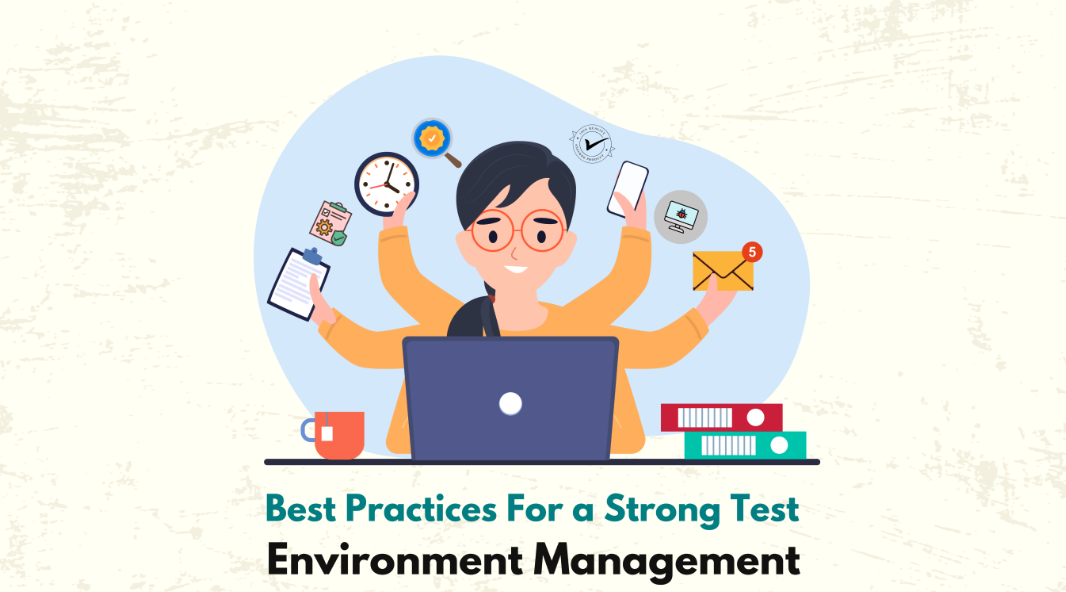
Test Environment Management Best Practices (Image by E2EWorx)

Test Environment Management Best Practices (Image by E2EWorx)
In software development, effective test environment management best practices foster a controlled environment for defect detection and quality assurance.
We realize the challenges of Test Environment Management (TEM) such as scarce resources, varying configurations, and team coordination are common.
That’s why effective test environment management best practices result in reliable, efficient test environments where software behavior is predictable and consistent.
With that in mind, here are six comprehensive TEM best practices. Each best practice is designed to streamline workflow and improve both software reliability and team productivity.
Test Environment Management (TEM) is a core aspect of software development that integrates several key components: hardware, software, data, and network configurations. Each element plays a different but related role.
Hardware is the physical foundation of TEM. Hardware is the foundation for creating a realistic test environment mirroring the production environment.
By closely aligning test hardware with production, teams can accurately anticipate how software will behave in real-world scenarios.
Software, the heart of TEM, includes the applications and operating systems under test.
Software is integral to ensuring smooth operation across platforms and versions, underscoring the importance of diversity in the test environment.
Data is the lifeblood of testing. Data must reflect actual operational data to effectively validate software functionality.
But it’s equally important to manage sensitive data securely, especially to comply with data privacy regulations.
Network configurations are the backbone that connects all components. You need to replicate the network conditions of your production environment to test how your software responds to different network scenarios.
Your hardware, software, data, and network configurations are all consistent and work together seamlessly.
Tests run smoothly and accurately reflect the performance of your software.
Finding problems early means fixing them is less expensive. And everyone involved-developers, testers, and users-is relieved to know that the software is reliable.
This framework is the real power of effective TEM: maintaining a stable test environment that delivers trustworthy software every time.
In Test Environment Management (TEM), there are six practices that stand out, crucial for any business in IT.
These practices are the pillars supporting the bridge between successful software development and effective testing.
Environment planning stands out as for setting up a testing space and strategic approach that ensures your software development journey is on the right path.
The essence of environment planning lies in its meticulous preparation phase.
So, before any testing begins, it’s crucial to document every detail of the hardware and software requirements.
This step might seem like a basic task, but its impact is profound. By accurately documenting these requirements, you establish a clear roadmap.
That roadmap guides not just the immediate testing phase but also influences future scalability and adaptability of the test environment.
The benefit here is twofold. Firstly, it reduces the risk of unexpected issues during the testing phase.
When you know exactly what hardware and software are required, you eliminate the guesswork. This leads to a smoother, more efficient testing process.
Secondly, this thorough documentation serves as a valuable reference, aiding in quick resolution of issues and facilitating easier updates and changes down the line.
Configuration management ability is to maintain order and consistency in the often chaotic world of software testing.
Configuration management involves meticulously overseeing every aspect of the test environments, especially focusing on version control.
In the dynamic landscape of software development, numerous versions of applications and systems coexist.
Here, configuration management ensures that every test environment is aligned with the specific version it’s meant to test.
This alignment is critical; without it, you’re essentially flying blind, not knowing if the tests are valid for the version in production.
Another key aspect is automation in configuration management. Manually keeping track of configurations for various environments is not just cumbersome but prone to human error.
Automation steps in as a game changer. It not only simplifies the process but also brings a level of precision that manual processes can’t match.
This automation ensures that every environment is set up consistently, eliminating discrepancies that could skew test results.
In essence, effective configuration management underpins the whole test environment management strategy.
It’s not just about keeping things in check; it’s about ensuring that the environments are accurately reflecting the production setup, leading to more reliable and efficient testing.
This strategic approach is what sets apart successful software development projects.
Data management is the strategic handling of test data, which includes practices such as data masking and anonymization.
This data management best practice includes specific techniques, such as data masking and anonymization, which are integral to the management of test data.
Data masking is a technique that obscures sensitive data elements and replaces them with fictitious but realistic data.
Masking ensures that the data used in test environments does not compromise real personal or sensitive information, thereby complying with data privacy regulations.
Anonymization goes a step further by removing or modifying personal identifiers in the data to ensure that individuals cannot be identified, either directly or indirectly.
The above best practices ensure that the integrity and usefulness of data for testing purposes is maintained, while eliminating the risk of sensitive data exposure.
This is critical in today’s era of stringent data privacy laws and increasing cybersecurity threats.
In addition, having realistic and representative data is paramount in testing. This means test scenarios are as close to real-world situations as possible, providing a reliable basis for assessing software performance and behavior.
Inaccurate or unrealistic test data can lead to misleading test results, which in turn can lead to software that does not perform as expected in real-world scenarios.
The integration of robust data management practices into your test environment management strategy is therefore not only a matter of compliance and security, but also a step towards more reliable and effective software testing.
This approach not only supports legal and ethical standards, but also enhances the credibility and reliability of the testing process. Ultimately, this contributes to the development of robust and trustworthy software products.

The primary challenge in TEM is maintaining an uninterrupted, efficient testing process. Test environments are complex and dynamic, making it difficult to keep track of every change and its impact on the overall system.
So, that’s why real-time monitoring involves using tools and software that continuously observe and record the performance of various components within the test environment.
Real-time monitoring allows for immediate detection of issues, be it a sudden crash or a performance bottleneck. This instant feedback is crucial for maintaining the health of the test environment.
The real impact, however, comes from the role of reporting. The data collected from real-time monitoring is compiled into detailed reports.
These reports do more than just log incidents; they provide crucial insights into the test environment’s performance.
By analyzing these reports, teams can identify patterns, pinpoint recurring issues, and understand the overall health of the environment.
This understanding is key to optimizing performance and ensuring that the test environment is always aligned with the needs of the software being tested.
Thus, in the bigger picture of TEM, environment monitoring and reporting are not just tasks; they are essential practices that keep the testing process transparent, under control, and continuously improving.
In the intricate world of TEM, collaboration and communication emerge as crucial practices. Why?
Because test environments are not isolated systems. They are interactive ecosystems involving multiple teams – developers, testers, operations, and more.
Effective collaboration means these teams are not just working alongside each other; they’re actively sharing information, insights, and updates.
On the other hand, real-time monitoring plays a vital role here. Real-time monitoring is not just about keeping an eye on the systems; it’s about providing a continuous stream of information that feeds into the collaborative effort.
When a test environment experiences an issue, real-time monitoring tools instantly communicate this to all relevant parties, fostering a proactive approach to problem-solving.
We provide a detailed list of test environment management tools for you to choose from based on your business needs and budget.
Then, you will use reporting as a documentation tool, logging every incident, change, or update in the test environment.
But more importantly, reporting acts as a communication bridge, converting data into actionable insights.
These reports are crucial for team meetings, strategy sessions, and decision-making processes, ensuring everyone is on the same page.
Security measures are a non-negotiable best practice because it is not just about securing data.
Security measure is a comprehensive strategy covering multiple dimensions of the test environment.
The security measures strategy includes protection of the environment from unauthorized access, assurance of data integrity, and compliance with data privacy laws.
One of the key practices is the implementation of robust access controls. This means defining and enforcing who can access the test environment and what they can do within it. It’s about keeping tight control over both physical and digital access points.
Moreover, compliance with data privacy regulations is another critical element.
Test environments often handle sensitive data, which can be subject to various regulations like GDPR (General Data Protection Regulation) or HIPAA (Health Insurance Portability and Accountability Act).
Implementing practices like data masking and anonymization becomes crucial. These techniques ensure that while the data remains useful for testing purposes, it does not violate privacy laws.
In order to adapt and strengthen processes to meet the challenges of 2024 and beyond, test environment management best practices are necessary.
As we navigate through these complex IT landscapes, it is important for us to adopt these best practices not just as a set of guidelines, but as an integral part of our business and IT strategies.
This approach will ensure resilience, efficiency, and success in our efforts. Remember, the clarity of our methods and the depth of our understanding directly affect the outcomes of our projects.
Let’s commit to these best practices, understand their importance, and apply them with precision and thoughtfulness.